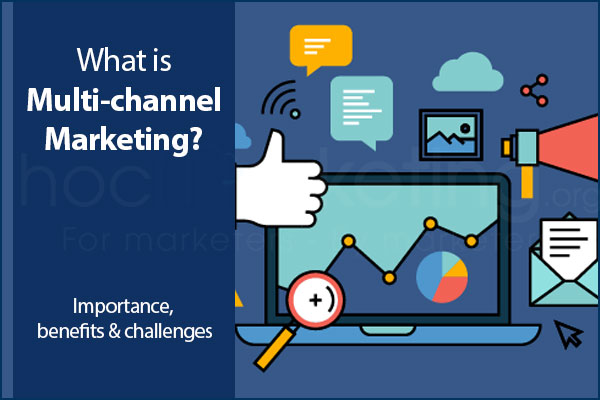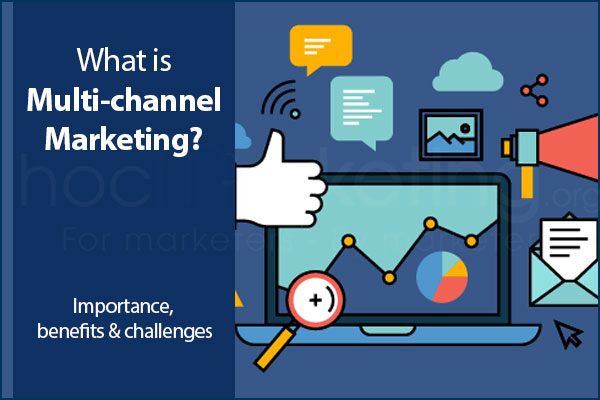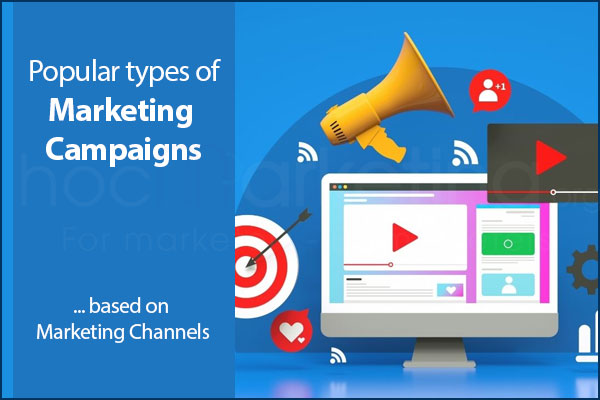
What is Multi-Channel Marketing? Importance, benefits & challenges

Marketing channels are the paths a product or service takes from production to consumption. There are three main marketing channels - offline, online, and what is commonly known as multi-channel marketing. In this article, we will explain what it means to be a multi-channel marketer and how to develop your own multi-channel marketing campaign.
Marketing channels are the paths a product or service takes from production to consumption. There are three main marketing channels - offline, online, and what is commonly known as multi-channel marketing. In this article, we will explain what it means to be a multi-channel marketer and how to develop your own multi-channel marketing campaign.
What is Multi-Channel Marketing?
Multi-channel marketing is the practice of interacting with customers via different channels both online and offline. Indirect communication channels involve interaction above the customer's inhibitions, often through one-way media like email or social media. Direct communication channels are more invasive and will allow for collaboration between parties.
Multi-Channel Marketing is the process of marketing to customers through multiple channels. The goal of Multi-Channel Marketing is to reach customers where they are most active and engaged. This helps businesses create a holistic and complete customer experience.
It's important to market yourself through multiple channels because not all of your customers are limited to one site. They're active on many platforms – so you shouldn't be, either. Multichannel shoppers typically spend three to four times more than single-channel consumers.
Marketing through various channels is an effective way to reach and engage customers. Social media can let you reach a large number of people quickly. Email marketing will provide the opportunity to nurture relationships with past customers who have opted into your list. The brick-and-mortar store will give customers the chance to try products before buying them online, which is especially beneficial for clothing retailers. Lastly, online marketplaces will allow retailers to make the most of their inventory by listing items on several websites at once.
Importance of Multi Channel Marketing
The reasons for multichannel marketing are
- Increases the customer pool: The more channels you are present on, the greater your customer pool.
- Builds relationships with prospects: Multi-channel marketing allows you to interact with prospects and customers on multiple channels.
- Multi-channel marketing allows businesses to target customers with personalised messages based on their specific needs and interests.
- Enables companies to track customer behavior: A multi-channel marketing strategy can provide a company with the opportunity to collect customer data across channels and use it to improve the overall customer experience.
Key Steps to Creating a Successful Multi-Channel Marketing Campaign
1. Break Down Organizational Silos & Identify your buyer persona
The first step to implementing a successful Multi-Channel Marketing campaign is breaking down the silos within your company. This means you'll need to identify the buyer persona for your product or service before developing a tailored campaign. Once you have identified the right buyer persona, create a tailored campaign by identifying their needs and interests.
2. Leverage a Multi-Channel Marketing Platform
The key to a successful Multi-Channel Marketing campaign is to use a Multi-Channel Marketing Platform. A platformed will allow you to manage your marketing across all channels, which will save you time and money by reducing the duplication of effort across multiple channels.
3. Understand Your Target Audience
After you define your target audience and their needs, it's crucial to put together a campaign specifically aimed at those needs. First, research to understand their wants and interests so that you can create a campaign that meets them in their place of need.
4. Choose the channels you want to target
To get a successful strategy, the first step is to figure out the areas where your marketing dollars will have the most impact. Just because there are plenty of channels available doesn't mean they're all right for you. Some of the most popular channels include social media, email, direct mail and online marketplaces.
5. Create Consistent Messaging
The fifth step to having a successful MMM campaign is to have the same message across all of your channels. For example, your message should be tailored to your target audience so that they understand what you're trying to say. Your message should be consistent with each platform so that prospects on one channel can easily translate it if they happen to see it on another channel as well.
6. Play by the rules of each channel
The sixth step of a successful Multi-Channel Marketing campaign is to abide by the rules of each channel. Each marketing channel has its own set of rules, so it's important to follow them if you want to be successful. Failure to do so could result in your campaigns being removed or banned from the platform.
7. Figure out how you’ll integrate the experience across channels
With a successful multi-channel marketing campaign, it's important to make sure that customers are able to access the content from their preferred channel. That means you need to consider your customers and prospects across all channels, with the same quality of experience. Imagine if different channels provided drastically different experiences for the same company. This would make it hard for people to engage and stay interested in your company.
8. Implement marketing automation
It can be hard to find the time to do marketing tasks such as sending email campaigns and updating social media. That's where marketing automation comes in. It allows you to automate your marketing so you can focus on other important aspects of your business. In order for it to be effective, you must have someone who is ready and willing to maintain a human interaction with your customers. Marketing automation won't replace that, but it will save you a lot of time and money if you let it do the work for you.
9. Keep in mind that your website is a channel
The ninth step to becoming a success in Multi-Channel Marketing is to never forget that your website is a channel, and that means you need to optimize it for search engine optimization. This will not only increase rankings, but it will also help your audience find you with ease.
10. Plan how you’ll measure attribution
The tenth step in creating a successful Multi-Channel Marketing plan is to determine how you will attribute success. Attribution methods are different, so it's important to choose the one that best fits your business.
11. Invest in retargeting
The eleventh step to creating a successful Multi-Channel Marketing campaign is to invest in online advertising. This will let you target potential customers who have already shown interest in your product/service, effectively increasing brand awareness and conversion rates.
Multichannel marketing can be an effective way to reach your target audience. Follow these eleven steps and you'll be well on your way to creating a successful campaign that will propel your business forward.
Marketing channels are fundamental to multi-channel campaigns
- Email: You can use email to reach your target audience through various channels such as newsletters, product announcements, and special offers.
You can use text messages to reach your target audience with short, personalized messages.
- Push Notifications: Delivering timely messages to audiences is exactly what push notifications are great for.
- Mail: Direct mail is an easy way to reach your target audience with a physical mailing.
Social media is a powerful way to reach your target audience. Some of the most popular platforms include Facebook, Twitter, and Instagram.
- Blogging: You can use blogging to reach your target audience through well-crafted, informative articles.
Though TV may be an old-fashioned method of connecting with your target audience, commercials and infomercials can still be powerful.
Websites help with digital marketing because they can be used through banner ads and pop-ups.
Items claimed to have been reworded and/or rewritten are not always as described.
Physical stores are an amazing way to reach your target audience with in-store promotions.
Mailing lists let you reach your target audience through mailed catalogs.
What are the benefits of Multi-Channel Marketing?
1. Expanded Reach: A great way to reach a new audience is by utilizing multi-channel marketing. This will allow you to target more channels at the same time, which means you'll be able to reach a wider audience.
2. Engagement: Multi-Channel Marketing increases your engagement with your target audience. Using multiple channels ensures that you are providing a more engaging experience to your target market.
By reaching your customers on the channels they prefer, you can guide them to where you want them to be. In addition, it ensures that you'll be able to meet them where they're already spending their time.
In Multi-Channel Marketing, you can combine multiple platforms into one campaign. This is important because it allows you to create a more effective campaign. Combining different channels can be very effective for reaching your target audience.
Common mistakes made when using Multi-Channel Marketing
1. Not Defining Your Target Audience: When we're marketing a product, one of the most common mistakes is not defining our target audience. This is a mistake because we'll be wasting time and money on channels that will never reach the people we want to sell to. When marketing your business, it's important to figure out who you want to talk to, and make sure your marketing efforts are focused on them.
2. Not Determining Your Goals: It's important to have specific goals when using a multi-channel strategy. A common mistake is not measuring success if there aren’t clear objectives in place.
3. Not Testing Your Campaign: Another common mistake made with Multi-Channel Marketing is not testing your campaign. This is a mistake because you will not be able to determine what is working and what is not working if you do not test your campaign.
The final common mistake made with multi-channel marketing is not measuring your results. This is a grave mistake because you will not be able to determine the success of your campaign if your results are not measured.
Challenges of Multi-channel Marketing
1. Multi-Channel Marketing: One struggle with multi-channel marketing is delivering a consistent message across channels. It's important to make sure that your message is relevant for each channel you use.
2. Highly choreographed campaigns: What can greatly impact performance and wasted resources with Multi-Channel Marketing is when campaigns are highly choreographed. This is because you need to make sure that the channels are working together in harmony.
3. Marketing response attribution: Another challenge with Multi-Channel Marketing is marketing response attribution. That's because you need to be able to attribute the success of your campaign to each channel.
4. Management: The last, and perhaps most challenging, challenge of multi-channel marketing is efficient management. This involves having the ability to manage all of your channels efficiently in order to be successful.
5. Utilizing Marketing Analytics: Want to use Multi-Channel Marketing? That's great, but you can't get it wrong by forgetting marketing analytics. To be successful, you need to make adjustments as necessary and track the success of your campaign.
6. Adapting to Innovation: It's important to keep up with innovation when it comes to Multi-Channel Marketing, because there are new channels constantly being created, and you need to be able to adapt your campaign accordingly.
RACE Framework and SOSTAC
We use the RACE Framework and SOSTAC® to teach our courses.
The RACE Framework is a helpful tool for developing and implementing your Multichannel Marketing campaign. The RACE framework stands for Reach, Act, Convert, Engage.
The SOSTAC® framework is another helpful tool that can be used to create, implement, and measure your Multi-Channel Marketing campaign. The acronym stands for Situation, Objective, Strategy, Tactics, Action and Control.
You can find lots of channels to market your product on, but you need to determine which one will work best for you. That's where these two frameworks come in. They are useful for creating a Multi-Channel Marketing campaign, but the choice is ultimately up to you.
Multi-channel vs Cross-channel marketing
A multi-channel marketing strategy is a process of marketing to customers through multiple channels. This might include a variety of online and offline channels, such as social media, email, SMS, direct mail, and more.
Successful multichannel marketing means understanding each stage of your customers' journey and sending them targeted messages so they'll engage with you. This requires data input at every stage that will contribute to reliable and accurate messaging.
Cross-channel marketing is a term that you may hear used interchangeably with multi-channel marketing. However, cross-channel marketing specifically refers to the practice of tracking your customer journey across all channels and then using that data to create a better personalized experience for them.
Both multi-channel marketing and cross-channel marketing have become important for businesses. Yet, too much focus on either channel can result in lost opportunities elsewhere. Testing different channels and strategies is the best way to find the perfect balance for your business.
Example of Multi-Channel Marketing
Coca Cola is an amazing company that has achieved success through Multi-Channel Marketing. Coca-Cola uses a variety of channels such as television, radio, and print to market themselves to their audience. These channels have been successful in reaching the Coca Cola's target audience.
Coca-Cola’s Multi-Channel Marketing campaign is an example of a well executed campaign. Coca-Cola was able to reach its target audience by using a variety of channels. Coca-Cola’s success shows that Multi-Channel Marketing can be an effective way to reach your target audience.
Conclusion
Many companies are crossing channel boundaries to offer a more cohesive and in-depth marketing strategy to customers. This approach gives them the ability to see where customers engage with their campaigns, and it helps improve customer loyalty and drive more sales by identifying which channels are most effective for their target audiences. Multi-Channel Marketing Attribution can help identify the right channels for each individual campaign.
When multichannel marketing is done correctly, it can be a powerful tool to reach potential customers. Multi-channel marketing messages increase customer loyalty and help you earn more sales by understanding how your customers interact with your marketing efforts.
With the right systems in place and the right approach, you can use multi-channel marketing to reach your customers through a variety of channels at different points in their buying journey. This will optimize your lead generation, conversion, and sales.
What are your thoughts on multi-channel marketing? Have you used it before? Did you see significant results? We want to know what you think of this strategy. Let us know in the comments!








